INTRO:
It is not very often that a game’s story can far outshine its otherwise mediocre gameplay. Tepid and/or well-worn gameplay elements would not make for a good time, but the story can be engrossing enough to keep the player playing – at least for just one playthrough. Eastward is such a game.
PREMISE:
The trailer-like intro video already gives away much of what would happen – though many of the actual events in the game do not match what happens in that video. This is only the first example of the dissonance in the presentation of the game.
That said, the story begins with the main characters being in a community that lives underground. They have not seen the surface for generations, due to taboos (some of which would turn out to be out all too true). This would not have been a problem, except that one of the main characters is Sammy, a recent addition to the community and who claims to have memories of the surface.
The other main character is John, who is the one who found Sammy while out on a scavenging mission. John is a silent person, a fact that would be brought up by more than a few characters throughout the game. He also does not have much of a personality, and next to no volition.
Anyway, Sammy would soon get them in trouble – specifically, they are exiled and have to leave for the surface. The surface turns out to be a far more appealing place than the underground, but Sammy’s sojourn to the surface will also trigger events that had been long in the planning, with intended outcomes that are not good for everyone who lives.
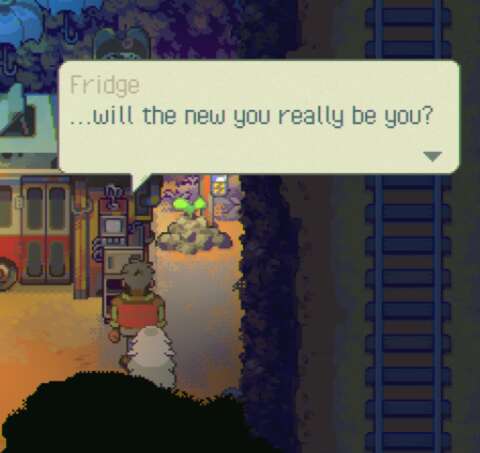
MOTLEY OF CHARACTERS:
Anyone who plays this game would have no doubt that its main appeal lies in the diverse characters in the story. John himself would be a contrast to all of them; as mentioned earlier, he has almost no volition and does not speak much, if at all. Everyone else would seem a lot more expressive, especially the secondary and tertiary characters who while not having much screen-time, would encompass just about every character trope that is known and perhaps more.
Sammy, as the various official promotional artwork for the game would suggest, is the main star. Much of the writing, story-telling, animations and other efforts for the game have been invested in her, and it shows.
CHANGING SCENERIES & COMMUNITIES:
To say anything more about the story and characters is to include one too many spoilers, of course. However, it has to be said that there are many distinct acts in the progression of the story, each with its own set of visually distinct artwork. John and Sammy will be going to many places, some of which are esoterically sci-fi.
In particular, they will be visiting communities with very different compositions in their residents. For example, one of them happens to be a city that is built onto the wall of a dam (for better or worse), and it has a notable number of sentient robots among its people.
CATCHY IN-GAME ARTWORK:
Every different community and locale has its own set of visual assets. The most striking of these are those for the aforementioned city on the face of a dam. There are many billboards, presumably intended to be references to previous works by Hayao Miyazaki and his contemporaries.
Not unlike games made with Unity, Eastward (which is made with Moai and “Gii”, Pixpil’s own IDE) makes use of a 3D game world with 2D sprites; a fixed camera perspective is used to give the impression of 2D graphics. The 3D game world allows the use of lighting effects that occur in real-time. The lighting is used quite well in this game, such as highlighting the billboards or presenting gloomy places.
MISMATCHING CONCEPT ARTWORK:
The concept artwork for the game is interesting, albeit not for entirely praiseworthy reasons. It would appear that previous iterations of the designs for the locales and characters have been packaged into the promotional material for the game and in the game itself.
A very notable example is that previous iterations of John have him being much more expressive than his actual in-game person. Sammy’s previous iterations have hair that is much less unruly too. However, both examples of earlier designs appear in the user interface of the gameplay.
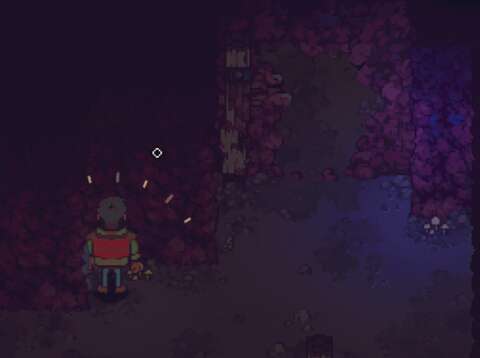
DESIGNS OF CHARACTERS:
There are many characters in the game, all of whom have distinctly different sprites. The only noticeable trend that can be discerned is that most characters have weedy-looking legs and comical hips.
Even the least important of characters have at least two sets of animations, one of which is used for when things get quite different from what they expect or when they do things that they do not usually do. This is just as well, because events would happen in the game such that things turn out uncomfortably different from what the people in the story are used to.
Sammy happens to have the most animations, as befitting one of the main characters in the story. It is not for nothing that one of the characters would call her “precious”; Sammy is a very entertaining and endearing girl, and many situations would give her the opportunity to show that.
In contrast though – perhaps deliberately intended by the developers – John does not have much of any expression. In most scenes, including even scenes where he should be concerned, he is just staring ahead. There are scenes in which core parts of his sparse personality is shown, but there are very few of these. Indeed, if not for the fact that John handles most of the proverbial heavy lifting, John is little more than Sammy’s guardian who follows her whims.
GAMEPLAY – OVERVIEW:
The gameplay is intended to be a tribute to the earlier Legend of Zelda games – like so, so many other indie titles before Eastward. The player characters would be going to a lot of places where the player gets a near top-down view, smacking things around like Link would with his sword. There are even animated flourishes when the player characters find treasure.
Of course, there are some designs that differentiate Eastward from other such indie titles; these will be described shortly. Still, they are nothing new in video games.
SHARED HEALTH METER:
There is a health meter that is represented with hearts. The hearts increase in number as certain milestones in the game are reached or when the player has found enough collectibles to raise them. This is also nothing new in video games.
That the player characters share the same health meter is a rare design though. There is no narrative explanation for this throughout the game. That said, there does not appear to be any difference between the hitboxes of the player characters, even though John is apparently a physically larger person.
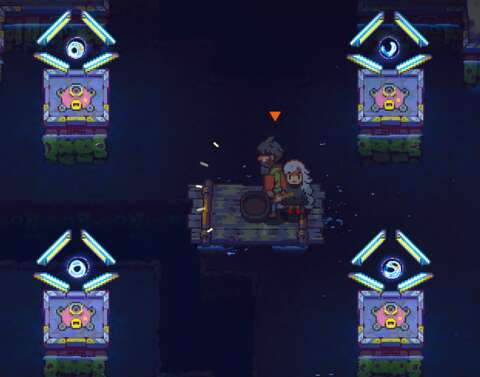
HEALING:
There are many things that can heal the player characters. Sometimes, enemies drop hearts that can be collected; these become increasingly rarer further on into the game.
The main means of healing is to eat food; the player characters are the kinds that get tangible and immediate benefits from food. Eating food is also instantaneous, at least in terms of in-game time; the player has to go into a menu to select which food to eat. Doing so will have the player exiting out of the menu, however. (Getting food is a matter that will be described later.)
Collecting heart orbs will refill the health meter; gaining an increase in the meter also does the same. Of course, there are rare occurrences.
Generally, it would not be difficult for the player to keep the health meter topped up, as long as the player remembers to restock healing items.
COOKING:
Conveniently, John is a naturally talented cook. Even if he does not know a recipe, he will learn it when given the ingredients to cook.
Gameplay-wise, all the player needs to have food cooked is to select the ingredients – John does the rest. There is a mini-game that resembles a one-armed bandit gambling machine, but this is a reflex-based mini-game that not every player would like. That said, getting a match of two icons improves the food that is cooked; three icons give an even bigger boost.
The exact type of ingredient is not important to a recipe. Rather, its overarching category is. For example, vegetable rice is always wholly cooked with ingredients that are categorized as vegetables; the exact type of vegetable is not important. (Actual culinary is a lot more complex than this, of course.)
BATTING:
Throughout the game, there are several occasions where John has to hit balls that are pitched at him. This is a reflex mini-game, with decent hitboxes for when John manages to hit the balls. There is one occasion in which John must deliver a charged hit in order to deflect a ball.
The problem with this mini-game is that the player is not given any tutorial on what to do; it is likely the player would flub the first try. Trial and error would eventually reveal what the player needs to do; that the player is usually given a chance to try again helps too.
JOHN’S WHACKING:
For most of the game, John would be the one whom the player would use to defeat enemies; Sam does not have the means to violently inflict harm on most enemies. Conveniently, the same implement that John uses to cook food and bat things – which is his frying pan – is sturdy enough to smash most things in.
Conveniently, the whacking also happens to partially stun-lock most enemies and push them away, thus setting them up for further hits. His swing arcs can also hit multiple enemies at once, which is just as well because he and Sammy are often outnumbered.
CHARGING WHACKS:
John can also charge up his whacks to deliver more powerful blows. In practice though, the charging is too slow to be useful in any combat situation other than the moments when the bosses are stunned. Even in these moments, the player might be better off simply having John whack the bosses repeatedly.
Charged whacks are only ever reliably used in solving puzzles. Conveniently, the player can change the direction of the charged whack at any time while it is being charged.
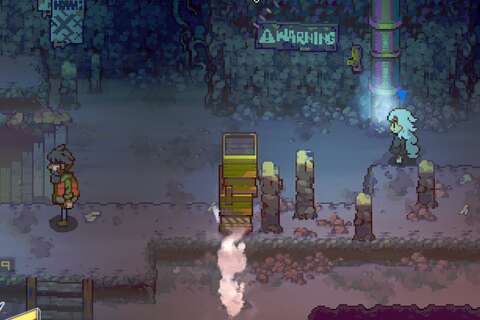
JOHN’S GUNS - OVERVIEW:
Eventually, John is given some arms by other people, or he cobbles them together from some schematics. These of course give the player some ranged means of eliminating enemies.
Controlling them with the mouse is quite easy, as to be expected of mouse-pointer controls, though the targeting reticules are not the usual that are seen in video games. Nevertheless, the reticules are not so bizarre as to be difficult to understand. For example, the reticule for the shotgun is represented as an arc, which shows the spread of the shots that would hit enemies.
SHOTGUN:
The shotgun is the first of the guns. It has very short range, but hits in a wide arc and has considerable damage per hit. On the other hand, the firing rate is not as fast as John’s swings with the frying pan, so the overall damage output is not that great.
FLAMETHROWER:
At the mid-point of the game, John receives the means to cobble together a flamethrower. As to be expected, this sets things on fire. They are meant to be used against pernicious weeds that also happen to be around during the introduction of the weapon, but they can also be used to set enemies alight.
For whatever reason – and there is an in-game statement about this – the weapon draws fuel from the same ammo reserve as the other guns.
DISC-LAUNCHER:
Late into the game, John receives a device that can launch discs that can bounce off walls. The player is not given any indication of where the discs would go and where they would bounce off to, but apparently the weapon comes with scripting that has the discs bouncing off in the direction of other things that they can hit. The discs harmlessly pass through John or Sammy, which is convenient.
In battle, the ricochets are not predictable enough to be reliable. However, if they connect with an enemy, the discs stun-lock it while inflicting considerable damage for a few seconds, thus giving the player an opportunity to have the player characters move away.
GUNS SHARE THE SAME AMMO:
In a quirky design decision that is highlighted in-game too, all of the guns share the same ammunition reserve. Although this makes for convenient design, this does pose a dilemma if the player is considering switching weapons during a fight.
Even with the upgrades to his ammo reserves, John is not likely to have enough ammo for a long fight. Therefore, strategies involving the use of guns are not always feasible, which in turn means that the player would be using John’s frying pan more often than not.
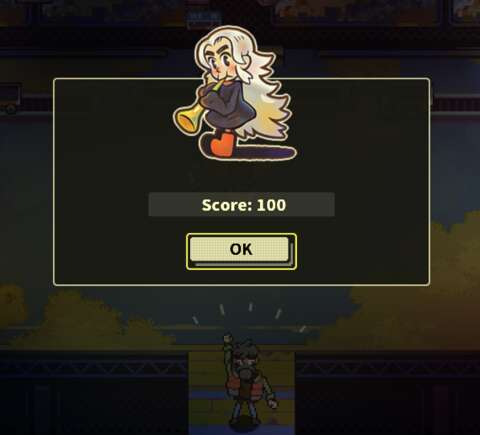
BOMBS:
As another nod to the first Legend of Zelda, John can deploy bombs. The bombs apparently originate from machines that seem to be drawing ordnance from somewhere; there is no clear source of these munitions, at least not so early in the story.
Anyway, the standard bombs are laid down and would generally stay where they are; John can hit them away with his frying pan. The direction of the hurling is decided by the direction of the mouse cursor relative to John’s sprite, in the case of mouse controls. There are many obstacles and puzzles early on in the game that would impress the need to smack the bombs around.
The balloon bombs are introduced next. These are practically drones, because they will fly towards the nearest enemy, obstacle or object that can be harmed or otherwise affected by the explosions. However, they have a limited range in which they can detect things that they can bomb. They are also not as powerful as the standard-issue bombs.
The remotely-detonated bombs are introduced last. These render the standard bombs near-obsolete in the matter of removing obstacles and solving puzzles. However, the same control input to detonate them is the same that is used to place them, meaning that the player cannot deploy remote bombs as rapidly as the player could with the standard bombs.
REPLENISHING AMMO AND BOMBS:
There are barrels here and there that can be broken to reveal bombs and ammo, though not every barrel is guaranteed to yield stuff. The game does appear to consider the levels of reserves that the player has, but ultimately fickle luck is the main factor in determining the yields of barrels. As mentioned earlier, there are also dispensing machines that readily provide resupplies for free.
There are also vending machines that sell restocks; incidentally, these machines also offer the upgrades for the reserve capacities.
SAMMY’S POWERS - OVERVIEW:
It is obvious very early on that Sammy is not a regular child. Her voluminous white hair that is too much for her age should already be a sign of that, but her esoteric powers would make that clear if the former is not enough.
RECHARGEABLE ENERGY RESERVES:
Sammy cannot use her powers continuously; there is no narrative explanation for this by the way. That said, this limitation is represented as two meters, one of which is for Sammy’s rechargeable energy reserves. Sammy uses this energy to launch her bubbles of light.
LIGHT BUBBLES:
That said, the first of her powers is said bubbles. They are not very impressive, initially. She fires forth bubbles of light and electricity, which have very short range. However, any enemy that is hit is stunned for several seconds. There are also some puzzles that require her to hit things with bubbles.
If the bubbles hit something, the energy is lost and Sammy has to recharge it later. If the bubbles do not hit anything, they return to Sammy and she gets the energy back. This conveniently allows the player to have Sammy spam bubbles to keep an enemy at bay.
However, if she does consistently hit whatever that can be affected by the bubbles, she will rapidly run of energy to launch any more bubbles. This is the player’s cue to do something else, such as switch over to John.

CHARGING BUBBLES:
Sometime into the story, Sammy learns how to pump more power into a bubble. There are several stages of these, each one indicated by a flourish that appears over Sammy’s sprite. After the highest stage has been reached, the player can continue to have Sammy hold the bubble back, if the player wishes to readjust the aim.
More powerful bubbles stun enemies for longer; in the case of enemies that are grievously vulnerable to the bubbles, the charged versions can obliterate these outright. However, charging takes a while, but unlike John’s swings, the charging cannot be entirely interrupted by harm that is inflicted on Sam; it can only be stalled. Unfortunately, this difference is not something that the game informs the new player about.
ACCUMULATED ENERGY RESERVES:
The other meter represents the energy that Sammy has to accumulate by absorbing motes of light that are released from defeating enemies or breaking barrels; there is no narrative explanation for these motes. Anyway, the energy from these motes has to be accumulated such that the meter is full; only then can this energy be unleashed through several ways.
UNLEASHED POWERS:
Incidentally, the meter is introduced together with the first method. The first of these is a burst that emits from Sammy, stunning every enemy on-screen with the exception of bosses.
The other two powers have to be obtained from finding hidden vaults. There is no narrative explanation for the presence of these in the world, but their significance to the story is implied much later when the finale approaches.
That said, the vaults have puzzles that have to be solved by applying lessons that have been learned in other puzzles that have been encountered earlier. Sammy is primarily involved in these, mainly because the devices in these vaults can only be powered by her.
The player’s reward is another power for Sammy to absorb. John is completely unperturbed by the esoteric process through which this happens.
Anyway, the first of these additional powers is a temporary energy shield. This renders both Sammy and John resistant to most forms of harm. The second additional power is healing-over-time, which only ends after its duration has expired or when the health meter has been completely refilled.
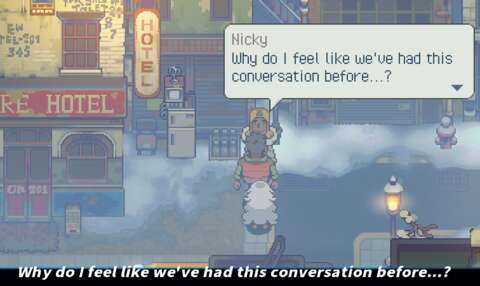
SONIC-PUNK:
Not every situation would have barrels waiting for the player to smash them, dispensers are far and few in between, and vending machines are only in the calm moments before the storm.
Thus, there is Sonic-Punk, a drone that is introduced close to the mid-point of the story. The Sonic-Punk’s main purpose in the gameplay is to bring an instant resupply of bombs and ammo for John and energy reserves for Sammy, as well as complete healing. This is a potent pick-me-up that is balanced with a long cooldown time, so the player will want to be sparing with its use.
CONVENIENT PLACEMENTS OF REFRIGERATORS, COOKING UTENSILS AND VENDING MACHINES:
Throughout the game, the player would find refrigerators and cooking stoves just before important battles; vending machines are often alongside these, and there are sometimes coolers containing cooking ingredients. There are not many narrative excuses for these conveniences, though the game does make light of their presence sometimes.
Speaking of the refrigerators, these are sentient machines that can store both food and memories, though the latter function is apparently only something that is offered to John and Sammy (thus acting as a game-save feature of sorts).
AWFUL EARLY CHASE SCENE:
For most of the game, observation and simple timing would get the player through just about every situation. This is so for most of the early-game moments.
The only exception is a scenario that would frustrate players who have been easily getting through the scenarios before this one. This is a chase scene, and one that would end with a game-over if whatever is chasing the player character happens to catch up.
Prior to this scenario, there have been no situations with game-over conditions that are difficult to avoid. Thus, the new player would have to memorize the twists and turns that the player characters have to get around through multiple failures before finally succeeding.
DRASTICALLY DIFFERENT GAMEPLAY AT THE END:
Unfortunately, the aforementioned chase scene is not the only moment in the game where mandatory scenarios throw proverbial curveballs at the player.
The second and final boss fights in the game would have the player timing strikes mainly on reflex. No other scenarios have this gimmick.
The player has no alternative but to keep trying over and over until the player gets one’s responses to the visual and audio cues right. These scenarios are far removed from the earlier boss fights, in which the player is given quite a lot of space to move around while observing the enemy’s patterns.
Such drastically different gameplay in these bits and pieces of the game strongly reinforce the previously mentioned impression that the game had incoherent sequence of designs.
BIZARRE INCLUSION OF SUBTITLES:
There is an option for the player to enable subtitles, even though everyone communicates through speech bubbles with readable text. This gives the impression that the game might have been intended to have full voice-overs; if this is so, the subtitle feature would be left-over coding. This would not be surprising, considering what has been mentioned about the incongruence in the visual presentation of the game.
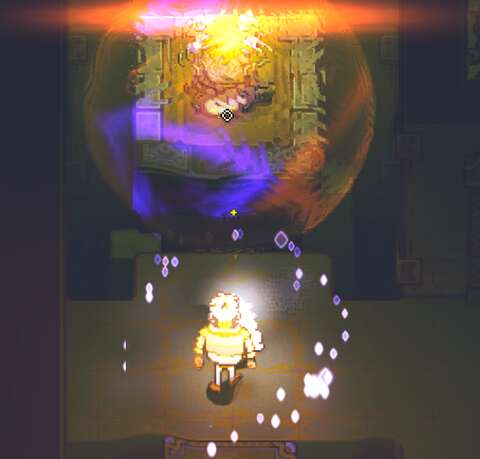
EARTHBORN & GACHA MACHINES:
The developer Pixpil has worked another game into Eastward. A certain character in the story has developed a game, “Earthborn”, in conjunction with gacha machines that appear in some places in the game-world. These will be described in another review article, because Earthborn is substantially different from Eastward such that describing both in the same article would make for unwieldy reading.
SOUND DESIGNS:
The sound designs for the game have been mostly outsourced to Hyperduck Soundworks, with the lead composer being Joel Corelitz of that company. This is just as well, because the audio assets of the game are the most coherently directed of the assets.
The music is of course the most prominent of these assets. There is the energetic main theme, which did much for the trailer of the game. Understandably, it plays at the most exciting moments in the story.
The other tracks have been composed with similar care. For example, there is “Another Day”, a somewhat cheery track that is used for the chapters in which Sammy and John acclimates themselves to life in New Dam City.
These tracks go a long way in enhancing the immersion of the game. Indeed, with the music disabled, much of the game would be revealed as just another indie take on Legend of Zelda and Earthbound.
As mentioned earlier, none of the characters have legible voice-overs. The composers tried to provide unique noises for the beeping that occurs when speech text appears on-screen in the case of some characters, but audio clips being reused for multiple characters occur often. When compared to games like Undertale that set the bar in this matter, Eastward falls short.
Only three characters have voices that can be discerned as human grunts or groans: John, Sammy and a certain secondary character that only gets to have audio clips much, much later in the story.
There are ambient noises, usually used to indicate the presence of machines in the environment. The rain that falls on some days in New Dam City also has ambient audio assets made for it.
As for combat, there are distinct audio clips for every occurrence in combat, though the player does not need to heed most of them. The only major exception is the aforementioned last two battles in the game, during which the player has to keep an ear out for audio cues while watching for visual cues.
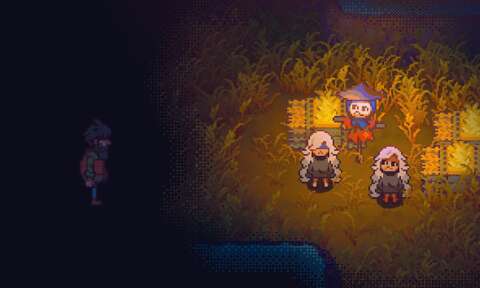
SUMMARY:
Incongruence in the design direction of Eastward may have resulted in its inconsistent visual styles and the occasional scenarios with gameplay that is frustratingly different from the usual gameplay that has been established by earlier games. These flaws mar an otherwise decently designed game that happens to have a very riveting story with memorable presentation.

